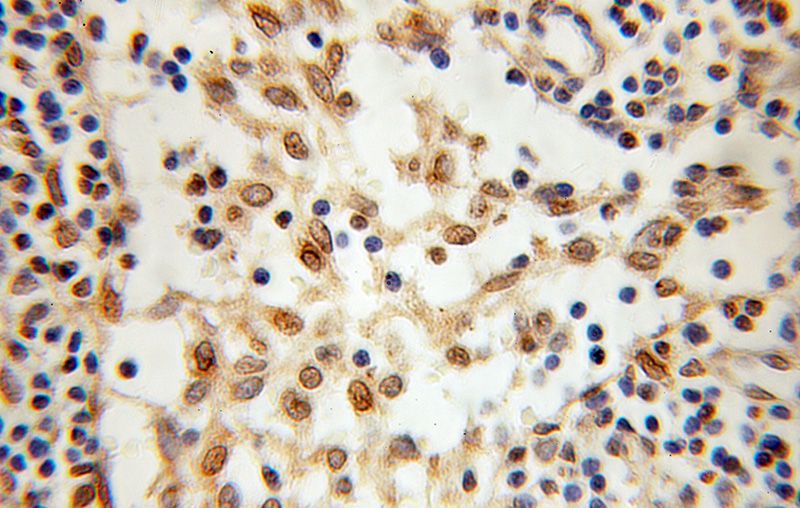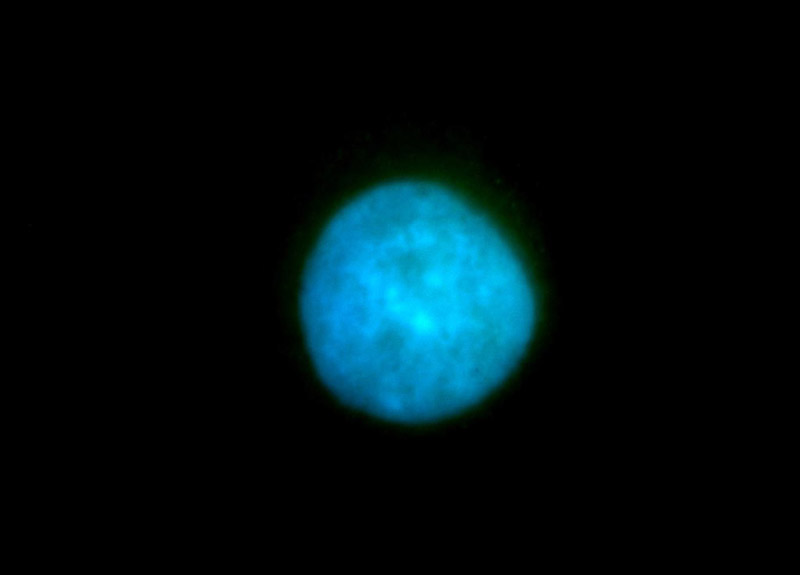-
Product Name
RBM15 antibody
- Documents
-
Description
RBM15 Rabbit Polyclonal antibody. Positive IF detected in HepG2 cells. Positive IHC detected in human breast cancer tissue. Positive WB detected in HEK-293 cells, A431 cells, K-562 cells, MCF7 cells. Observed molecular weight by Western-blot: 100-107 kDa
-
Tested applications
ELISA, WB, IHC, IF
-
Species reactivity
Human,Mouse,Rat; other species not tested.
-
Alternative names
FLJ12479 antibody; FLJ21943 antibody; One twenty two protein 1 antibody; OTT antibody; OTT1 antibody; RBM15 antibody; RNA binding motif protein 15 antibody; SPEN antibody
-
Isotype
Rabbit IgG
-
Preparation
This antibody was obtained by immunization of RBM15 recombinant protein (Accession Number: BC006397). Purification method: Antigen affinity purified.
-
Clonality
Polyclonal
-
Formulation
PBS with 0.1% sodium azide and 50% glycerol pH 7.3.
-
Storage instructions
Store at -20℃. DO NOT ALIQUOT
-
Applications
Recommended Dilution:
WB: 1:500-1:5000
IHC: 1:20-1:200
IF: 1:20-1:200
-
Validations

HEK-293 cells were subjected to SDS PAGE followed by western blot with Catalog No:114599(RBM15 antibody) at dilution of 1:1000

Immunohistochemical of paraffin-embedded human breast cancer using Catalog No:114599(RBM15 antibody) at dilution of 1:100 (under 10x lens)

Immunofluorescent analysis of HepG2 cells, using RBM15 antibody Catalog No:114599 at 1:100 dilution and FITC-labeled donkey anti-rabbit IgG(green). Blue pseudocolor = DAPI (fluorescent DNA dye).
-
Background
RNA-binding motif protein 15 (RBM15) belongs to the SPEN protein family, which have repressor function in several signaling pathway, and may bind to RNA through interaction with spliceosome components. It was first described as a 5′ translocation partner of the MAL gene in t(1,22)(p13;q13) infant acute megakaryocytic leukemia, and it functions in murine hematopoiesis through modulating Notch-induced transcriptional activation, which play crucial roles in leukemogenesis. Decreasing RBM15 levels with RNA interference could inhibit the growth and proliferation, block the cell cycle, and induce apoptosis in CML cells.
-
References
- Uranishi H, Zolotukhin AS, Lindtner S. The RNA-binding motif protein 15B (RBM15B/OTT3) acts as cofactor of the nuclear export receptor NXF1. The Journal of biological chemistry. 284(38):26106-16. 2009.
- Zolotukhin AS, Uranishi H, Lindtner S, Bear J, Pavlakis GN, Felber BK. Nuclear export factor RBM15 facilitates the access of DBP5 to mRNA. Nucleic acids research. 37(21):7151-62. 2009.
- Majerciak V, Deng M, Zheng ZM. Requirement of UAP56, URH49, RBM15, and OTT3 in the expression of Kaposi sarcoma-associated herpesvirus ORF57. Virology. 407(2):206-12. 2010.
- Majerciak V, Uranishi H, Kruhlak M. Kaposi's sarcoma-associated herpesvirus ORF57 interacts with cellular RNA export cofactors RBM15 and OTT3 to promote expression of viral ORF59. Journal of virology. 85(4):1528-40. 2011.
- Lee JH, Skalnik DG. Rbm15-Mkl1 interacts with the Setd1b histone H3-Lys4 methyltransferase via a SPOC domain that is required for cytokine-independent proliferation. PloS one. 7(8):e42965. 2012.
- Majerciak V, Lu M, Li X, Zheng ZM. Attenuation of the suppressive activity of cellular splicing factor SRSF3 by Kaposi sarcoma-associated herpesvirus ORF57 protein is required for RNA splicing. RNA (New York, N.Y.). 20(11):1747-58. 2014.
- Massimelli MJ, Majerciak V, Kang JG, Liewehr DJ, Steinberg SM, Zheng ZM. Multiple regions of Kaposi's sarcoma-associated herpesvirus ORF59 RNA are required for its expression mediated by viral ORF57 and cellular RBM15. Viruses. 7(2):496-510. 2015.
- Moindrot B, Cerase A, Coker H. A Pooled shRNA Screen Identifies Rbm15, Spen, and Wtap as Factors Required for Xist RNA-Mediated Silencing. Cell reports. 12(4):562-72. 2015.
Related Products / Services
Please note: All products are "FOR RESEARCH USE ONLY AND ARE NOT INTENDED FOR DIAGNOSTIC OR THERAPEUTIC USE"
